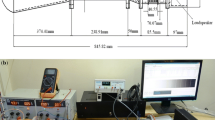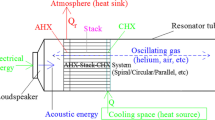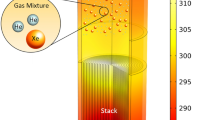Abstract
Conventional refrigeration system poses a major threat to the environment due to emission of harmful gases (CFC, HCFC). Hence, there is a need for an alternative. Thermoacoustic refrigeration, an alternative to conventional refrigeration, offers a wide scope for further research. It functions by passing high intensity sound waves through a porous stack or regenerator placed inside a resonator tube. Due to the pressure pulsations and the oscillatory motion of the gas, a temperature gradient is created on either side of the stack. Heat exchangers utilize this cooling. This paper deals with the fabrication of the model of the system and analyzes the performance in terms of temperature difference, by varying the stack material, its position inside the resonator, type of input wave and the frequency of the wave. Optimization by design of experiments is also done. A maximum temperature difference of 5.42 oC was obtained at the best combination of its parameters. Results obtained from the experiment are in agreement with the results obtained from Taguchi analysis.
Similar content being viewed by others
References
T. Mathewlal, G. Singh, C. Devadiga and N. Mendhe, Demonstration of thermo acoustic refrigeration by setting up an experimental model, IOSR Journal of Mechanical and Civil Engineering (IOSR-JMCE) (2014) 29–33.
M. Yadav and K. I. Solanki, Effect of working gases and stack material on a thermoacoustic refrigerator–A review, International Journal for Innovative Research in Science & Technology (IJIRST), 1 (11) (2015) 142–144.
P. Mahamuni, P. Bhansali, N. Shah and Y. Parikh, A study of thermoacoustic refrigeration system, International Journal of Innovative Research in Advanced Engineering (IJIRAE), 2 (2) (2015) 160–164.
F. Zink, J. S. Vipperman and L. A. Schaefer, Environmental motivation to switch to thermoacoustic refrigeration, Applied Thermal Engineering, 30 (2010) 119–126.
N. M. Hariharan, P. Sivashanmugam and S. Kasthurirengan, Influence of stack geometry and resonator length on the performance of thermoacoustic engine, Applied Acoustics, 73 (2012) 1052–1058.
N. M. Hariharan, P. Sivashanmugam and S. Kasthurirengan, Experimental investigation of a thermoacoustic refrigerator driven by a standing wave twin thermoacoustic prime mover, International Journal of Refrigeration, 36 (2013) 2420–2425.
A. C. Alcock, L. K. Tartibu and T. C. Jen, Experimental investigation of ceramic substrates in standing wave thermoacoustic refrigerator, International Conference on Sustainable Materials Processing and Manufacturing (SMPM 2017), Procedia Manufacturing, 7 (2017) 79–85.
P. S. Bhansali, P. P. Patunkar, S. V. Gorade, S. S. Adhav and S. S. Botre, An overview of stack design for thermoacoustic refrigerator, International Journal of Research in Engineering and Technology (IJRET), 4 (6) (2015) 68–72.
B. A. Rao, M. P. Kumar and D. S. Rao, Design and experimental study of small-scale fabricated thermo-acoustic Refrigerator, International Journal of Engineering Trends and Technology (IJETT), 4 (9) (2013) 3830–3836.
J. George, Loud speaker driven thermo acoustic refrigeration, International Journal of Scientific & Engineering Research, 7 (4) (2016) 465–468.
Y. A. Abakr, M. Al-Atabi and C. Baiman, The influence of wave patterns and frequency on thermo-acoustic cooling effect, Journal of Engineering Science and Technology, 6 (3) (2011) 392–396.
H. Babaei and K. Siddiqui, Design and optimization of thermoacoustic devices, Energy Conversion and Management, 49 (2008) 3585–3598.
N. Yassen, Impact of temperature gradient on thermoacoustics refrigerator, International Conference on Technologies and Materials for Renewable Energy, Environment and Sustainability (TMREES15), Energy Procedia, 74 (2015) 1182–1191.
Author information
Authors and Affiliations
Corresponding author
Additional information
Recommended by Associate Editor Jae Dong Chung
Augustine Babu completed his B.E. in Mechanical Engineering from Sri Ramakrishna Institute of Technology, Coimbatore, Tamil Nadu, India in the year 2011. He received his Master’s degree in Thermal Engineering from Karunya Institute of Technology and Sciences, Coimbatore, Tamil Nadu, India in the year 2013. He is currently working as an Assistant Professor in Sri Ramakrishna Institute of Technology, Coimbatore, Tamil Nadu, India. His areas of interest include refrigeration and cooling systems, nanofluids and heat exchangers.
P. Sherjin completed his B.E. in Mechanical Engineering from Sri Ramakrishna Institute of Technology, Coimbatore, Tamil Nadu, India in the year 2017. He is currently pursuing his Master’s in Thermal Engineering at Karunya Institute of Technology and Sciences, Coimbatore, Tamil Nadu, India. His areas of interest include refrigeration and cooling systems, nanofluids and composite materials.
Rights and permissions
About this article
Cite this article
Babu, K.A., Sherjin, P. Experimental investigations of the performance of a thermoacoustic refrigerator based on the Taguchi method. J Mech Sci Technol 32, 929–935 (2018). https://doi.org/10.1007/s12206-018-0143-x
Received:
Revised:
Accepted:
Published:
Issue Date:
DOI: https://doi.org/10.1007/s12206-018-0143-x




